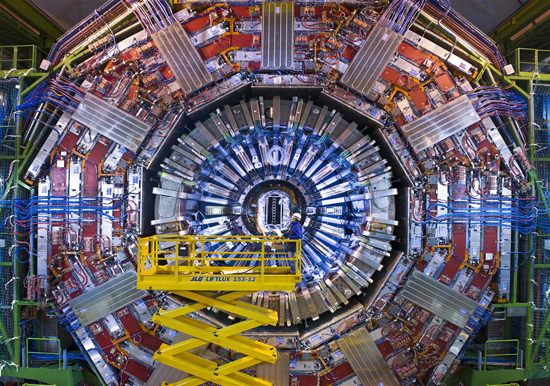European Organization for Nuclear Research, CERN, has scored a remarkable success with the Large Hadron Collider (LHC), which has set a new energy record ever achieved in a particle accelerator.
Scientists at CERN have announced having accelerated the twin beams of protons to an energy level of 1.18 TeV at the Large Hadron Collider, world’s largest and high energy particle accelerator. In doing so, they have tripled its former peak performance, which now stands at 3.5 trillion electronic volts. The beams are likely to collide by the end of this month.
The 17-mile-long underground tunnel in Geneva, Switzerland has set a new energy record by becoming world’s highest energy particle accelerator. CERN said they will try to collide beams at 7 TeV (3.5 TeV per beam) in the near future.
The world record for energy was achieved when beam 1 was accelerated from .450 TeV, to 1.05 TeV, which were, after some tome, accelerated to 1.18 TeV. The two 3.5-TeV beams will eventually be smashed into each other to create a banging 7-TeV energy collision, which is half the maximum energy level of the collider.
James Gillies, the CERN spokesperson, said, “We’re all hoping [the collision] will happen in the next couple of weeks. If things continue carrying on the way they’ve been, that’s a pretty safe estimate.”
After the beginning of the 7-TeV collisions, the Large Hadron Collider is likely to run for 18 to 24 months at a stretch and then it will be shut down for about a year or more. The shut down is extremely necessary to complete the repair work that had begun after an electric malfunction in 2008.
Gillies added: “We haven’t fully recovered from the problems we had in September 2008. There’s still work to be done on the machine before we can move to higher energy. And there’s routine maintenance—there always is with these machines.”
During the long break, CERN scientists will be busy with “bread-and-butter physics,” in the words of Gillies. It will give time for looking for evidence of new dimensions, particularly for Higgs boson or the God’s particle.
They will also try to reconfirm the standard model of physics with the LHC by making efforts to create elementary particles, such as top quarks, already seen in other machines.
In the words of Gillies, “That’s a big deal for us, to find top quarks. They’re popping out of the Tevatron [particle accelerator at Fermilab in Illinois] all the time, but we haven’t found them yet.”

